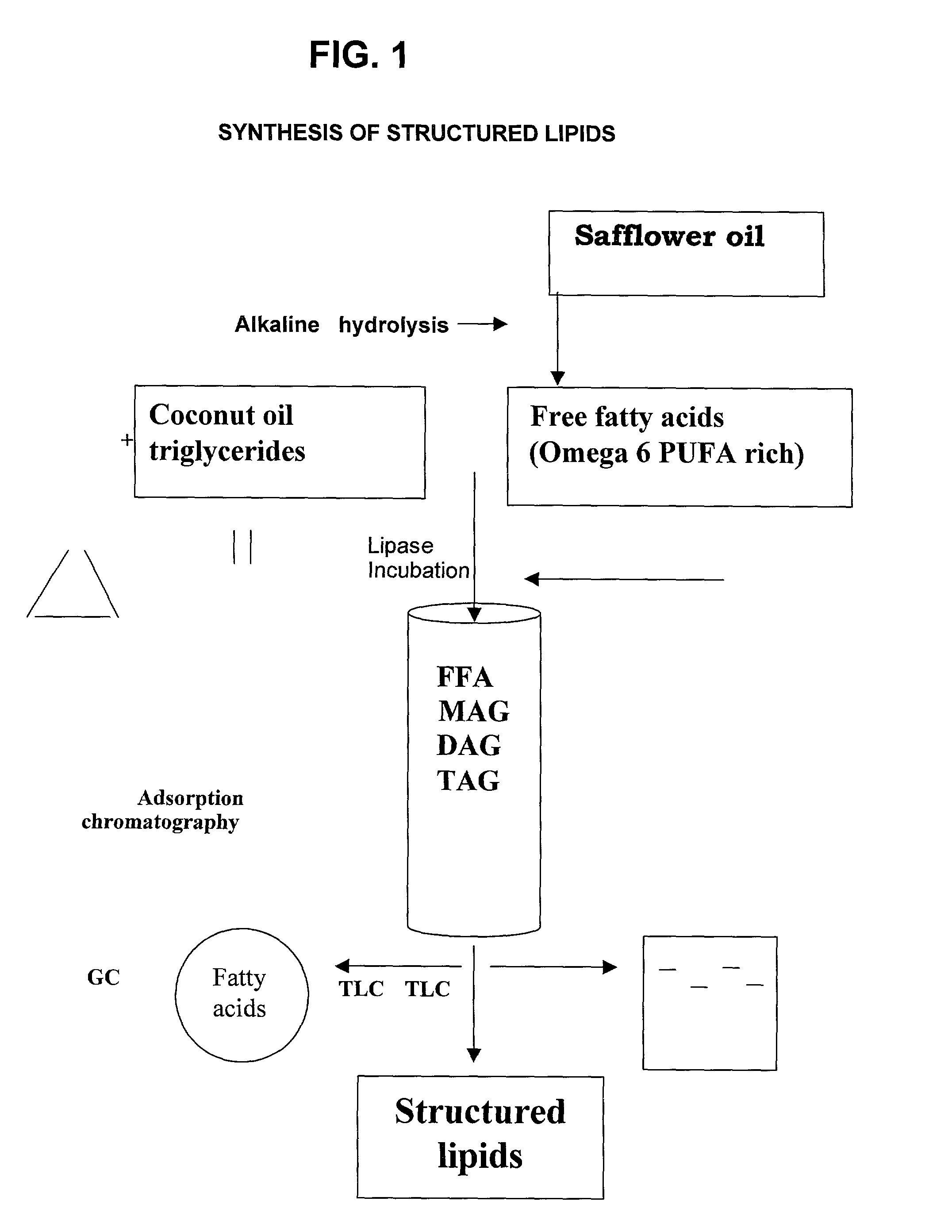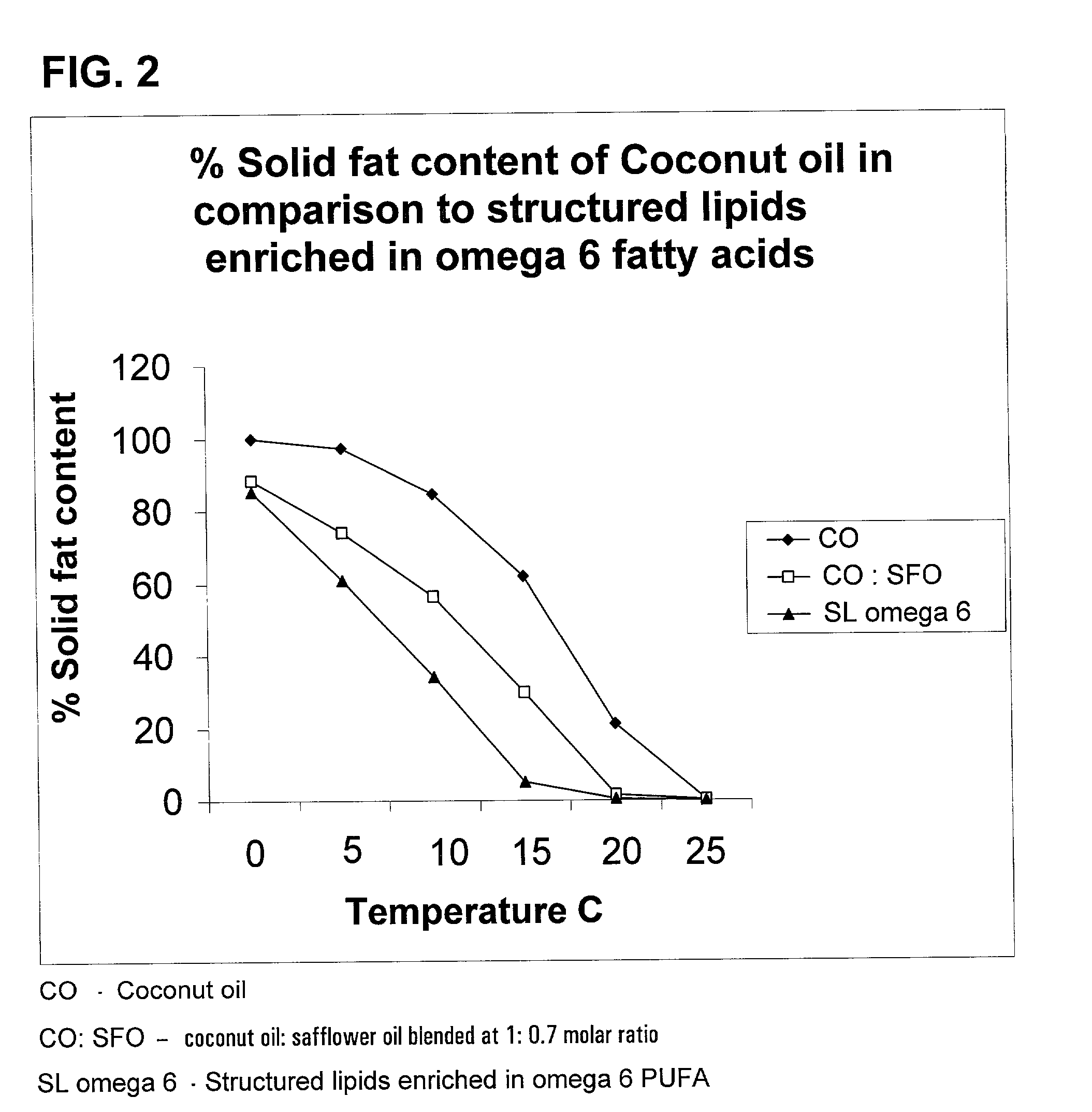Cholesterol lowering structured lipids containing omega 6 polyunsaturated fatty acids and the process thereof
a structured lipid and cholesterol-lowering technology, applied in the direction of fatty-oil/fat refining, drug compositions, metabolic disorders, etc., can solve the problems of efa deficiency symptoms, excessive water loss through the skin, scaly dermatitis, etc., and achieve the effect of quick energy
- Summary
- Abstract
- Description
- Claims
- Application Information
AI Technical Summary
Benefits of technology
Problems solved by technology
Method used
Image
Examples
example 2
[0056] Enzymatic acidolysis reactions were scaled up in lab scale batch reactions of 100 g triglycerides and 132 g of free fatty acids from safflower oil taken in a 2 liter Erlenmeyer flask that served as the bioreactor. 11.5 g of immobilized lipase was used and the reaction was carried out in 500 ml of hexane. Incubation was carried out for 48.5 hours at 39.degree. C. in an orbitally shaking waterbath.
[0057] Triglycerides were separated from the reaction mixture by column chromatography. A mixture of 20 g each of alumina and silica gel (100-200 mesh ize) were activated at 200.degree. C. for 2 hrs and cooled in a desiccator. Slurry of this was made in hexane and packed in 4 cm.times.35 cm glass columns.
[0058] 30 g of the sample from the reaction mixture was loaded on the column and eluted with 350 ml of hexane: diethyl ether (95:5 v / v). The fractions containing triglycerides were pooled and solvent was removed in a vacuum rotary evaporator. The purity of triglycerides was checked by...
example 3
[0060] The structured lipids were fed to rats in the diet as the sole source of fat at 10% levels for a period of 60 days. The serum and liver cholesterol was decreased by 10 and 36% respectively and the triglyceride level reduced by 17 and 16% respectively in the serum and liver.
2 Lipid Profile of Rats fed Coconut oil, Blends and Structured lipid Total Cholesterol Triglycerides Dietary Serum Liver Serum Liver Groups (mg / dl) (mg / g) (mg / dl) (mg / g) Coconut oil 74.54 .+-. 1.3 7.21 .+-. 0.2 169.90 .+-. 6.9 12.8 .+-. 2.2 Coconut oil: 74.76 .+-. 0.3 7.80 .+-. 1.0 169.5 .+-. 6.7 9.07 .+-. 0.9 Safflower oil (1:0.7) Blend Structured 66.84 .+-. 1.5 4.62 .+-. 0.3 140 .+-. 4.8 6.93 .+-. 0.7 lipid (omega 6 PUFA rich)
example 4
[0061] The structured lipids were subjected to DSC studies wherein their peak melting temperature and solid fat content was determined. The peak melting temperature of structured lipids enriched in omega 6 fatty acids was 12.7.degree. C. while that of coconut oil was 20.8.degree. C.
[0062] Advantages:
[0063] (1) The present invention uses fatty acids from natural sources to create novel structured lipids with potential impacts on nutrition and health
[0064] (2) The process could be employed for the modification of coconut oil, which is deficient in EFA by effectively incorporating omega 6 fatty acids.
[0065] (3) The production could be scaled up without loosing the efficacy of the process.
[0066] (4) The use of natural sources of triglycerides and fatty acids for the acidolysis reaction and the use of immobilized lipase which could be reused up to 25 cycles without loss of activity ensures that the process is economically viable.
[0067] (5) Nutritionally the structured lipid proved to be ...
PUM
| Property | Measurement | Unit |
|---|---|---|
| temperature | aaaaa | aaaaa |
| volume | aaaaa | aaaaa |
| melting temperature | aaaaa | aaaaa |
Abstract
Description
Claims
Application Information
 Login to View More
Login to View More - R&D
- Intellectual Property
- Life Sciences
- Materials
- Tech Scout
- Unparalleled Data Quality
- Higher Quality Content
- 60% Fewer Hallucinations
Browse by: Latest US Patents, China's latest patents, Technical Efficacy Thesaurus, Application Domain, Technology Topic, Popular Technical Reports.
© 2025 PatSnap. All rights reserved.Legal|Privacy policy|Modern Slavery Act Transparency Statement|Sitemap|About US| Contact US: help@patsnap.com


